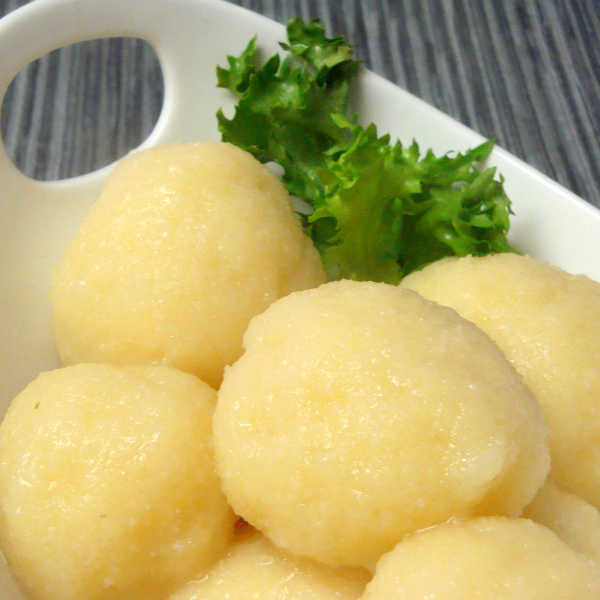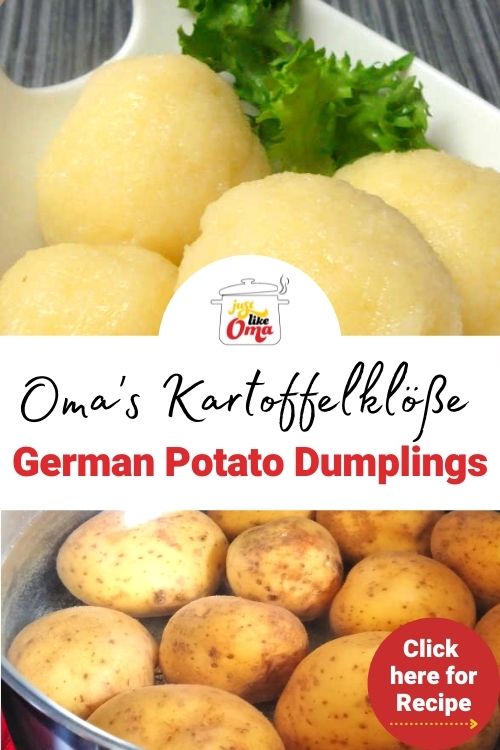Spice up your inbox with FREE German recipes and an exclusive free recipe ebook!
Biggest savings of the year! But our Black Friday Sale ends tonight!
Spice up your inbox with FREE German recipes and an exclusive free recipe ebook!
- Home
- German Potato Recipes
- German Potato Dumplings
Oma's Authentic German Potato Dumplings (Kartoffelknödel)

by: Gerhild Fulson / Oma Gerhild shares German recipes rooted in family tradition.
Updated: January 17, 2025
German potato dumplings (kartoffelklöße) are a family favorite, the perfect side to almost any meal. I’ll show you exactly how I make them.
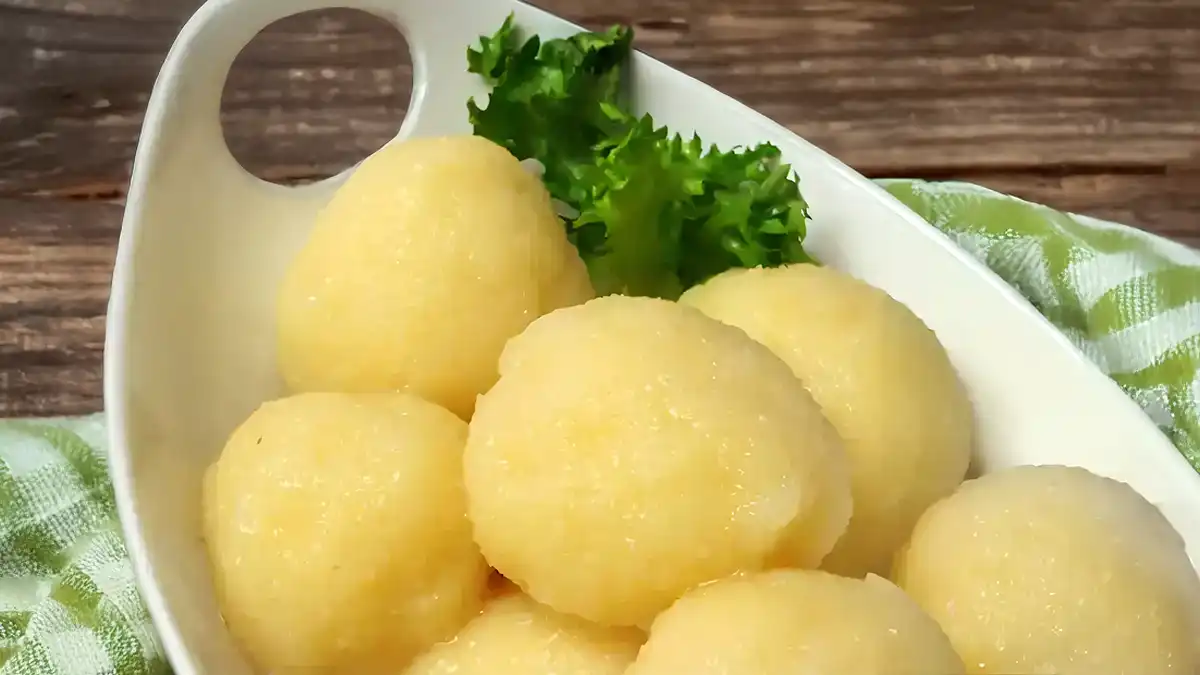 German potato dumplings aka Kartoffelklöße or Kartoffelknödel. MEGA LECKER!
German potato dumplings aka Kartoffelklöße or Kartoffelknödel. MEGA LECKER!German potato dumplings, aka kartoffelklöße and kartoffelknodel, bring back wonderful memories of my Mutti’s Sunday dinners. This traditional recipe, passed down through her generations, creates a classic dumpling that pairs beautifully with almost any meat dish and, of course, gravy.
I found this treasured recipe in my Mutti's handwritten cookbook filled with her German recipes. This page in her book with this recipe is so well-worn, showing just how much Mutti loved making these.
Oma's Recipe Rundown
- Ease of Making: Moderate — requires some hands-on effort but worth every minute.
- Taste: Soft and slightly earthy with a satisfying chew.
- Time: Approximately 1 hour 25 minutes (including chilling time).
- Best Served With: Sauerbraten, rouladen, or any dish with rich gravy.
- Gluten-Free: Yes, if using gluten-free bread for croutons or omitting them.
Top Tips For The Best Results
- Use High-Starch Potatoes: Opt for Russets to achieve the desired texture.
- Rice, Don't Mash: Using a potato ricer prevents gummy dumplings.
- Chill the Potatoes: Refrigerate riced potatoes overnight for easier handling.
- Test Before Committing: Cook one dumpling first to ensure it holds together.
- Vegan Hack: Replace eggs with flaxseed meal mixed with water; use plant-based butter for sautéing croutons.
Here's How To Make Oma's Recipe
(Find the printable recipe with measurements in the recipe card below.)
Cooking the potatoes in advance, either the day before or earlier on the day you plan to serve the dumplings, is essential.
Cook the potatoes in their skins. Boil them until tender, and don’t peel them beforehand. A knife should slide easily to the center when they’re done.
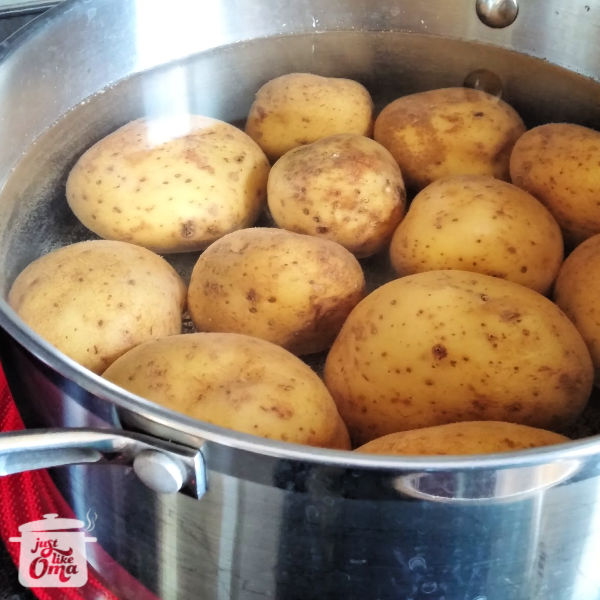 Ideally, you'll want to have similarly sized potatoes so that they will cook evenly.
Ideally, you'll want to have similarly sized potatoes so that they will cook evenly.Once cooked, let them cool slightly before peeling.
Rice the still warm potatoes, and then for best results, place them in the refrigerator until cold or overnight.
The Best Way To Rice Potatoes
For the smoothest texture, use one of these tools:
- a food mill
- a potato ricer or press (my favorite)
Note: Do not use a mixer. It makes the potatoes gummy, resulting in sticky, gluey dumplings—not the texture we’re after! If all you have is an old-fashioned potato masher, it will work, but it will also give a denser dumpling.
Personally, I prefer to use the ricer. Note that if the potatoes cool down, they can be tougher to press through a ricer, so it’s best to do this while they are still warm.
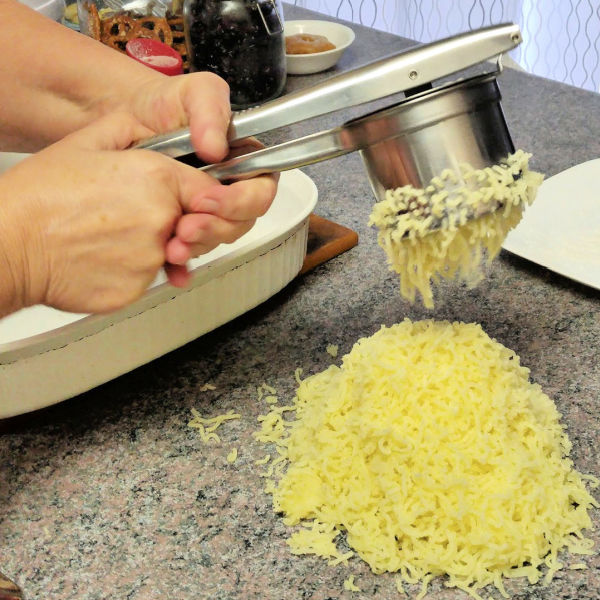 For the BEST German dumplings, use a potato ricer—never just mash them!
For the BEST German dumplings, use a potato ricer—never just mash them!Now, then, it's on to make the dumplings!
But first you'll want to make the bread croutons.
How To Make Croutons
The croutons add an extra layer of flavor and ensure a well-cooked dumpling. Here’s how to prepare them:
- About 4 slices of day-old bread will do. Cut the bread into small cubes.
- Heat 2 tablespoons of butter in a frying pan over medium-high heat until the butter melts.
- Stir the cubes frequently so they brown evenly to a golden color. Let them cool before adding to the dumplings.
Once the croutons are ready, it's time to make the dumplings. Add the ingredients to the cold riced potatoes, either on the counter or in a large bowl.
You can use either potato starch, potato flour, or cornstarch. The potato starch is more traditional, but since it wasn't available for my Mutti, she subbed in the cornstarch, and it worked just fine.
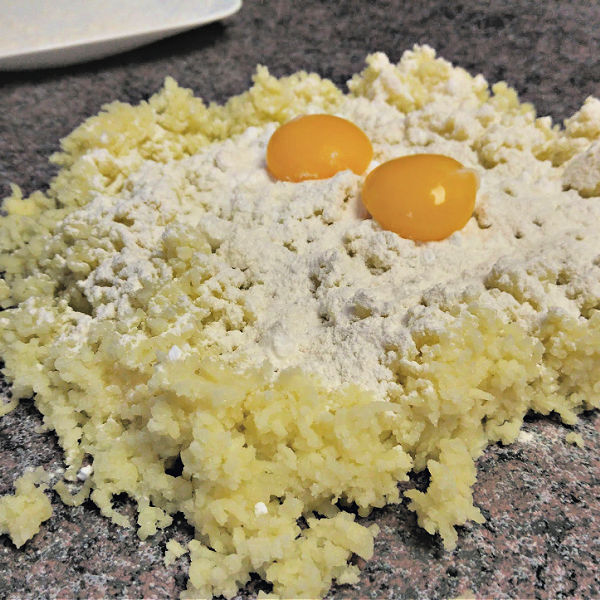 I can almost see a happy face here :)
I can almost see a happy face here :)Mix together with your hands until the dough holds together. Then divide the dough into portions and form the dumplings.
I like to use an ice cream scoop to measure out the dough. That way, the dumplings are similar sizes.
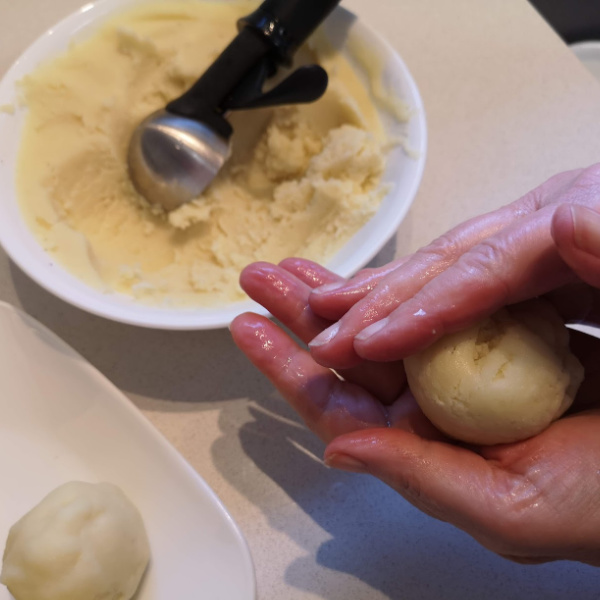 Using an ice cream scoop assures that all the dumplings will be a similar size, ensuring even cooking.
Using an ice cream scoop assures that all the dumplings will be a similar size, ensuring even cooking.To keep the dumplings from sticking to your hands when you are forming them, you can either wet your hands with water, or dust your hands with flour. Either way works.
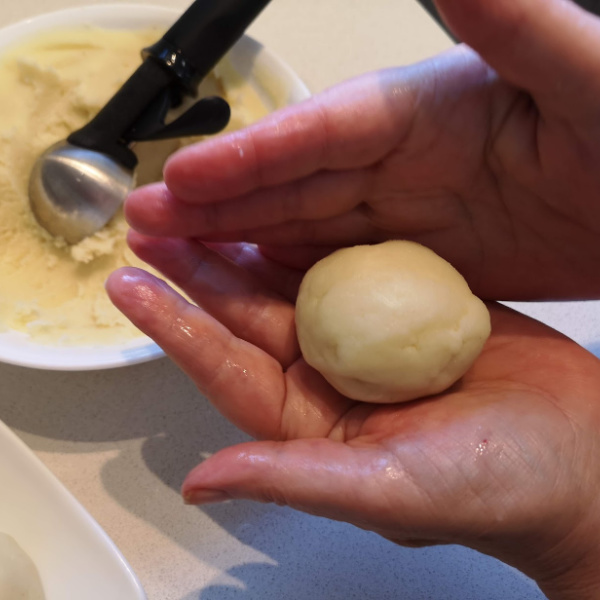 I prefer to wet my hands to keep the dumpling mixture from sticking and making it easier to form these dumplings.
I prefer to wet my hands to keep the dumpling mixture from sticking and making it easier to form these dumplings.Make sure you hide a couple of croutons in the middle. Push the croutons into the middle and then re-roll the dumpling to make sure the opening is totally closed.
Gently drop them into lightly salted, simmering water. They will sink to the bottom. As the water comes back to simmering, gently stir them so that they don't stick to the bottom.
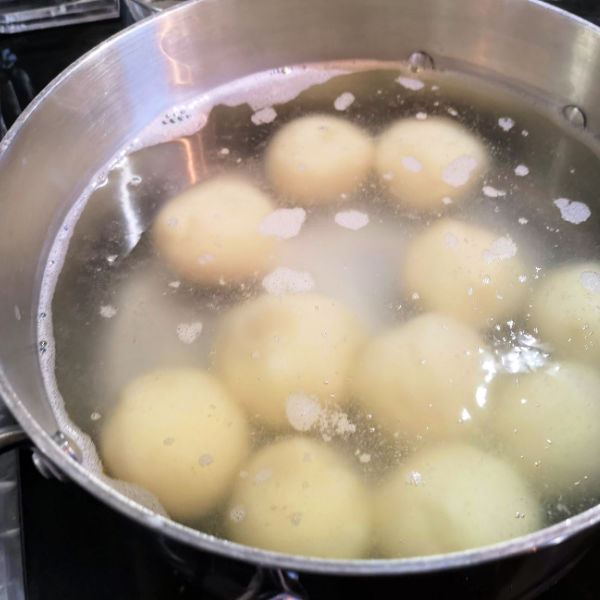 Don't let the water boil. A very, very gentle simmer is all you want.
Don't let the water boil. A very, very gentle simmer is all you want.Very gently simmer the dumplings. It's said that they are ready once they rise to the surface of the water.
For me, they often rise to the top shortly after they start to simmer. I let them continue to simmer for about twenty minutes, to assure that they are cooked through.
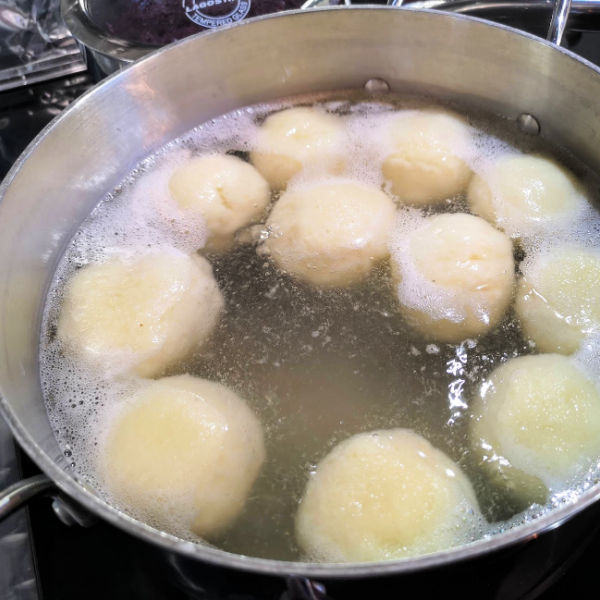 Floating to the top normally means they are done. However, wait out the cooking time so that they are cooked through properly.
Floating to the top normally means they are done. However, wait out the cooking time so that they are cooked through properly.When they are finished, remove them from the pot and serve immediately.
Serving Suggestions For Kartoffelknödel
Even though it is traditional to serve knödel with rouladen, they are just as delicious with sauerbraten or a tender roast pork.
Vegetable side dishes that go with these are rotkohl cabbage and sauerkraut.
If there are any leftover dumplings, they can be sliced and fried in butter for a delicious next-day treat. Served plain or with leftover gravy, they are simply irresistible.
In the photo below, I’ve served the dumplings with some leftover Dicke Bohnen und Speck — a hearty dish of broad beans and bacon. (You can find this recipe in my book, German Meals at Oma's.)
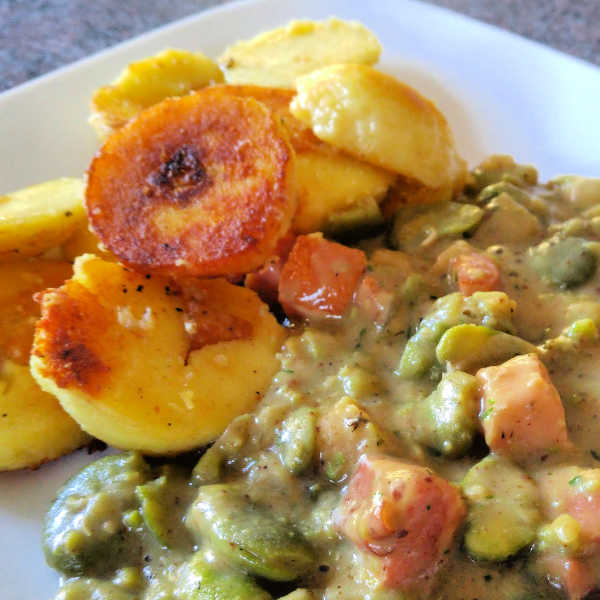 I always make more dumplings than needed, just to have leftovers to fry the next day, here served with "Dicke Bohnen und Speck" — a hearty dish of broad beans and bacon. Mega lecker!
I always make more dumplings than needed, just to have leftovers to fry the next day, here served with "Dicke Bohnen und Speck" — a hearty dish of broad beans and bacon. Mega lecker!Why Add Croutons?
When you look at the photo above, you'll see that dark section in the middle of one of the slices. Those are croutons. These dumplings taste best with butter-fried bread croutons nestled in the middle, so don’t skip that step, even if you’re in a hurry.
There’s also a practical reason for including the croutons: they help ensure the center of the dumpling is fully cooked! Because there’s no raw dough in the center, the dumplings cook faster and more evenly. Once you make them, you’ll understand exactly what I mean.
Oma Says,
Mutti had another recipe for kartoffelklöße called halbseidene klösse (half-silk dumplings) also called halb und halb (half and half), which combined boiled and raw potatoes.
It was her way of mimicking the more labor-intensive Thüringer klösse made from a raw grated potato dough, while making things a bit easier.
However, these "potato balls" (I find that a strange name that some people call these) recipe, that I've posted below, was her go-to recipe, especially as she got older and really appreciated being able to prepare parts of the recipe in advance.
That meant she’d cook the potatoes and rice them the day before, so she could quickly mix up the dumplings just before we came to visit. And, she’d always insist we come for dinner (how could we refuse?) since she enjoyed seeing us enjoy her food.
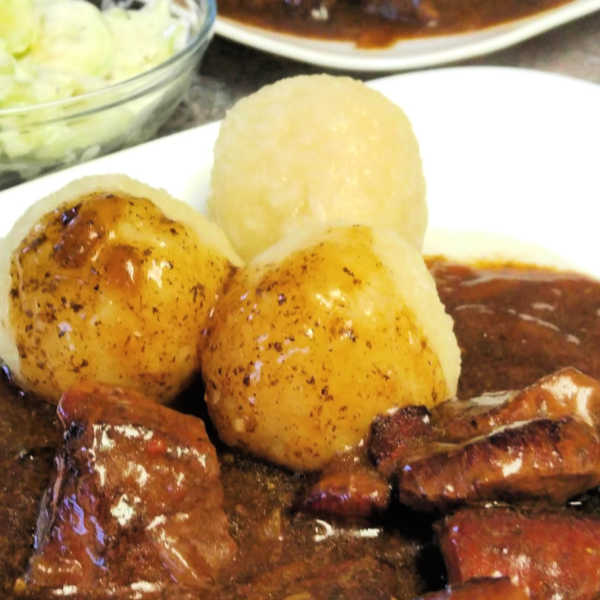 Kartoffelklöße and gravy. The perfect pairing. Add some meat and veggies. A dinner fit for royalty.
Kartoffelklöße and gravy. The perfect pairing. Add some meat and veggies. A dinner fit for royalty.For me, it's most important that there is always LOTS OF GRAVY when serving kartoffelklöße. Rouladen gravy or flatladen gravy is best!
Oma's Authentic German Potato Dumplings (Kartoffelknödel)
German potato dumplings (kartoffelklöße) are a family favorite, the perfect side to almost any meal. I’ll show you exactly how I make them.
Prep Time:
30 minutes
Cook Time:
25 minutes
Total Time:
3 - 4 hours
Servings:
4 servings
Ingredients:
- about 2¼ pounds (1.14 kilograms) starchy potatoes, cooked in their skins
- 4 slices day-old bread (see below)
- 2 tablespoons (28 grams) butter
- about 1⅓ cups (203 grams) potato starch or cornstarch (see below)
- 2 large eggs
- 3 teaspoons (18 grams) salt, divided
Instructions:
- The day before or several hours before making the dumplings, cook the potatoes (in their skins) in a large pot of water until fork-tender. Cool slightly and peel. Rice the potatoes. Let them become totally cold, cover, and refrigerate several hours or overnight.
- Make croutons by cutting bread into small cubes.
- Melt butter in a frying pan over medium heat. Add the cubes and fry, stirring frequently, until golden brown on all sides. Remove from heat and set aside to cool.
- To make the dumpling dough, in a large bowl, mix the potatoes that have been riced, 1 cup of starch, eggs, and 1 teaspoon salt into a smooth dough that holds together when formed into dumplings. If the mixture is too moist, add a bit more starch as needed.
- Divide into 12 to 14 dumplings, about the size of a tennis ball. Taking one ball, press a few croutons into the middle of the dumpling, then roll until smooth. Use floured or wet hands if necessary. Repeat with all the dumplings.
- Bring a wide pot of water to which you've added 2 teaspoons salt to a gentle simmer, then carefully drop in the potato balls and let them cook on a low simmer. They will sink at first, then rise as they cook. Simmer for 15 to 20 minutes.
- Remove the dumplings with a slotted spoon and serve immediately.
Notes/Hints:
- The first time you make this dumpling recipe, it's wise to make a test dumpling. That way you'll be sure it holds together before cooking the rest. Adjust with more starch or liquid if needed.
- If you're making this gluten-free, use GF bread for the croutons. Check that the cornstarch is GF if you're using it.
- This popular side dish is amazing with mushroom gravy, or onion gravy.
- There are different German potato dumpling recipes. Try Mutti's thüringer klösse ... these delicious dumplings are made with raw potatoes and SO good!
- Another quite different dumpling recipe to make are dumplings made with bread.
* * * * *
Unless otherwise noted recipe, images and content © Just like Oma | justlikeoma.com
01.17.2025 revision update
German Potato Dumplings FAQ
Why do my dumplings fall apart?
Why do my dumplings fall apart?
If they are falling apart as you are forming them, add a bit more liquid. If they fall apart as they are cooking, the dough was probably too wet.
Test cook one dumpling to make sure it stays together, before you cook the rest. If it doesn't, you'll need to add a bit of extra starch or liquid, depending on how sticky or dry your potato mixture is.
By the way, that 'test' dumpling is a great treat to nibble on while you cook the rest of the dumplings. One of the advantages of being the cook!
How do I store leftovers?
How do I store leftovers?
Refrigerate leftover dumplings, covered, for up to 4 days. To reheat, cook water that is barely simmering until heated through.
Can I freeze dumplings?
Can I freeze dumplings?
Yes, you can freeze cooked potato dumplings. Freeze them on a baking tray and then transfer them to a freezer container or a ziplock bag where they will keep for a month or two. To reheat, cook water that is barely simmering until heated through.
Are German potato dumplings gluten-free?
Are German potato dumplings gluten-free?
Yes, they are as long as if you use GF bread to make the croutons, or omit them if you don't have any, and if you use cornstarch making sure it is GF.
What are dumplings in German?
What are dumplings in German?
There are various words in dumplings in German. Some are Knödel, Klöße, Knedl, Kloßn, Kniedla, and Knädel.
Comments? Questions?
You can leave a comment about this recipe or ask a question...
Pop right over to my private Facebook group, the Kaffeeklatschers. You'll find thousands of German foodies, all eager to help and to talk about all things German, especially these yummy foods.
Meet with us around Oma's virtual table, pull up a chair, grab a coffee and a piece of Apfelstrudel, and enjoy the visit.
Recent Articles
-
German Gingerbread House Recipe: Oma's Traditional Lebkuchen
Nov 13, 25 07:27 AM
German Gingerbread House Recipe: A simple, spiced lebkuchen, honey cake perfect for building and decorating your own festive holiday centerpiece. Fun and delicious for all! -
German Pork Noodle Soup – Oma's Nudelsuppe mit Schweinefleisch Rezept.
Nov 05, 25 09:50 PM
Homemade pork noodle soup ... so easy to make a huge potful to satisfy the hungriest of families or a large party. -
German Marble Pound Cake Recipe – Oma's Marmorkuchen Rezept
Oct 31, 25 08:13 PM
This favorite marble pound cake recipe has been in our family for years. It's a traditional German Marmorkuchen that's easy to make.
Words to the Wise
"A wise child accepts a parent's discipline, a mocker refuses to listen to correction."
Proverbs 13:1 (NLT)



